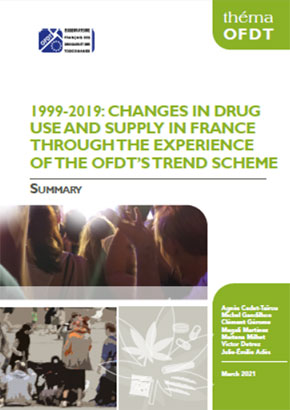1999-2019: changes in drug use and supply in France through the experience of the OFDT's TREND scheme
Summary
Summary, OFDT, 9 p.
March 2021
On the occasion of the 20th anniversary of the Emerging Trends and New Drugs (TREND) scheme and the National Detection System of Drugs and Toxic Substances (SINTES), the French Monitoring Centre for Drugs and Drug Addiction (OFDT) looks back on two decades of drug monitoring. An issue of the Théma collection1 published in September 2020 observed the major transformations that have taken place in the field of illicit and misused substances that these two schemes have been able to identify and analyse. After detailing the principles of the TREND-SINTES organisation and its adaptation to changes in practices, uses and contexts, this summary describes the main phenomena observed.
Authors : Agnès Cadet-Taïrou, Michel Gandilhon, Clément Gérome, Magali Martinez, Maitena Milhet, Victor Detrez, Julie-Émilie Adès
![]() Download the PDF file (589 Ko)
Download the PDF file (589 Ko)
![]() Read the complete report in French
Read the complete report in French
Drugs in Europe
![]() 2023 EMCDDA European Drug Report
2023 EMCDDA European Drug Report
The European Drug Report 2023: Trends and Developments presents the EMCDDA’s latest analysis of the drug situation in Europe. Focusing on illicit drug use, related harms and drug supply, the report contains a comprehensive set of national data across these themes and key harm-reduction interventions. This report is based on information provided to the EMCDDA by the EU Member States, the candidate country Türkiye, and Norway, in an annual reporting process.
The annual Statistical Bulletin contains the most recent available data on the drug situation in Europe provided by the Member States. These datasets underpin the analysis presented in the European Drug Report. All data may be viewed interactively on screen and downloaded in Excel format.
![]() The European Union and the drug phenomenon
The European Union and the drug phenomenon
 The European Union & the drug phenomenon : Frequently asked questions, joint publication between the EMCDDA and the European Commission, october 2010, 12 p.
The European Union & the drug phenomenon : Frequently asked questions, joint publication between the EMCDDA and the European Commission, october 2010, 12 p.




